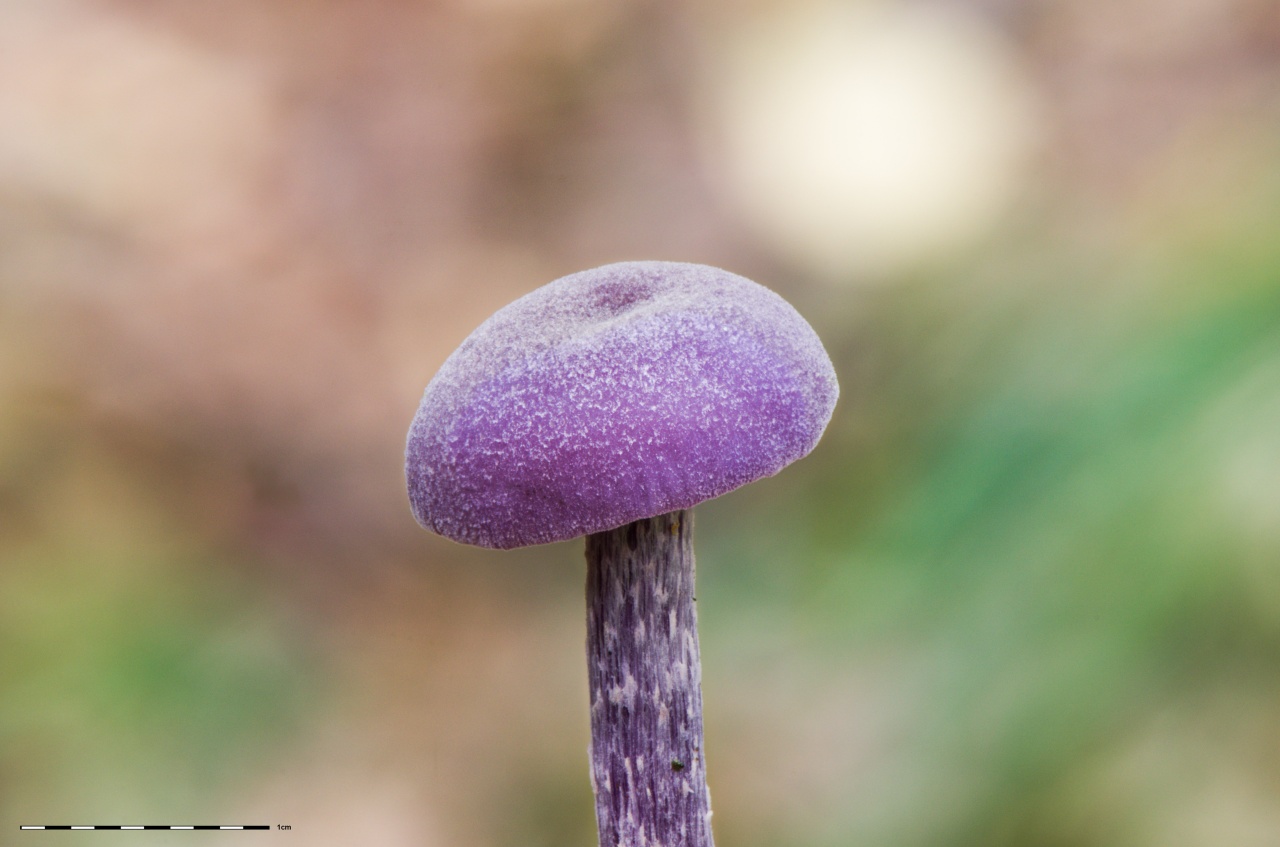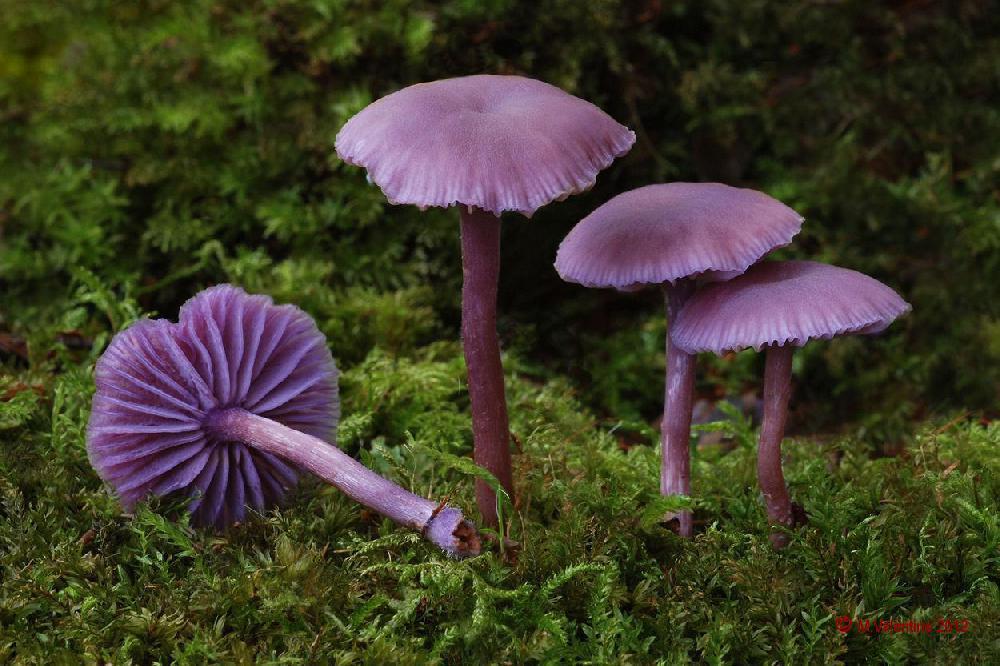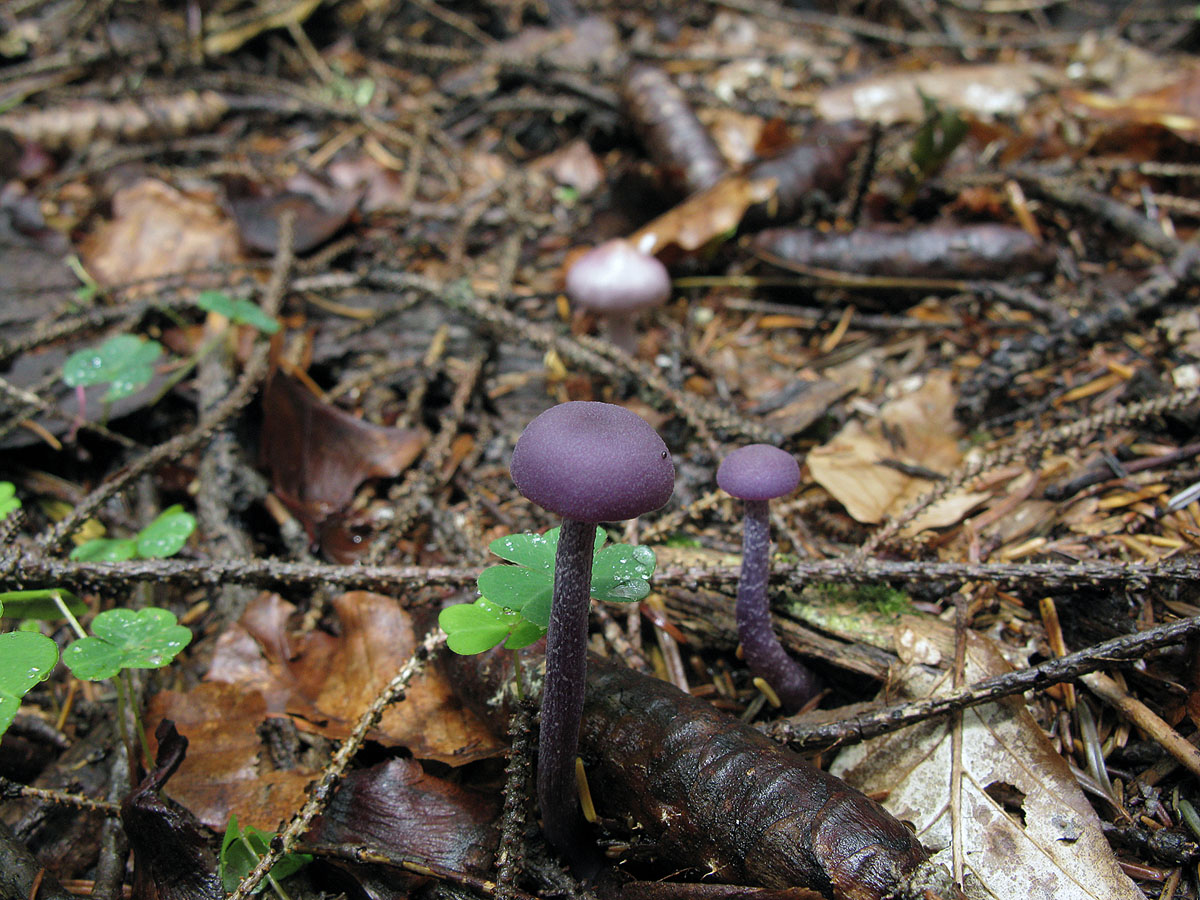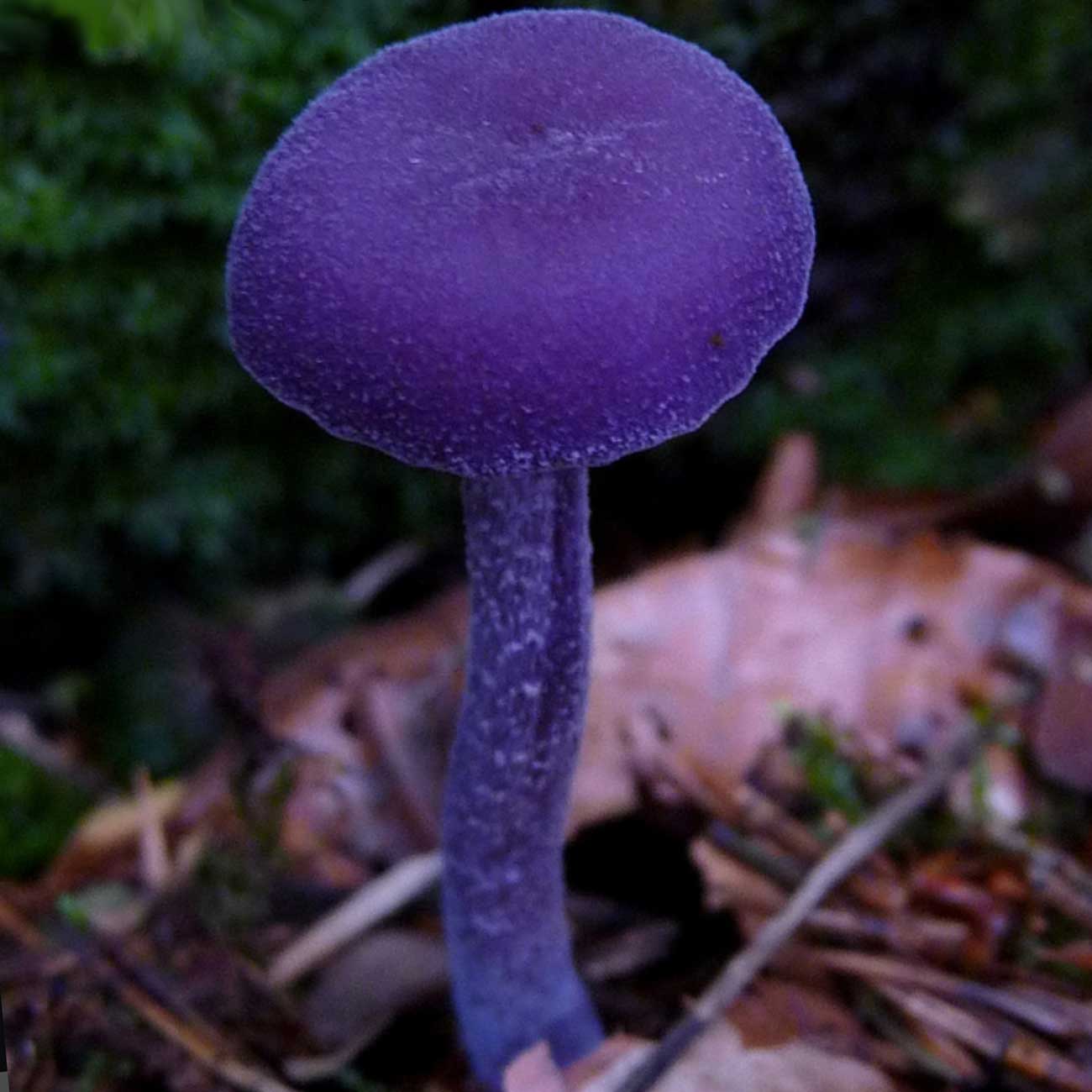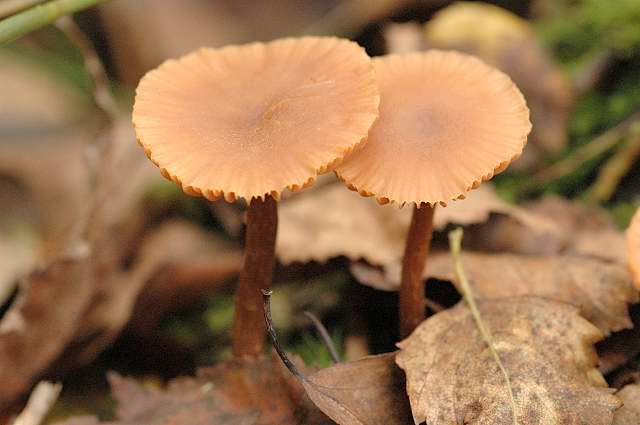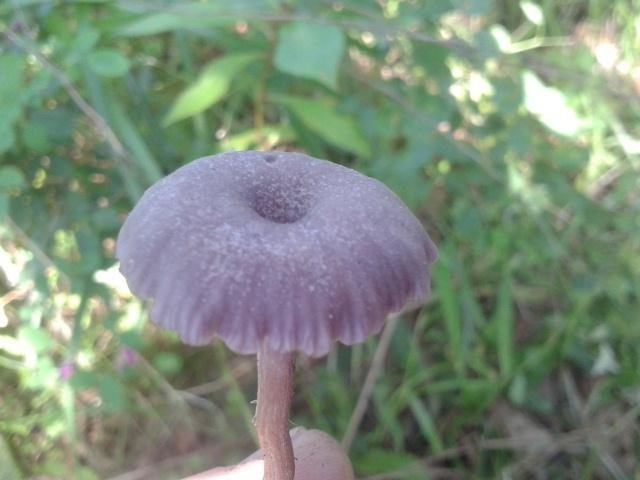Amethyst lacquer (Lilac lacquer) where it grows, how it looks, is it possible to eat
Amethyst varnish (lilac varnish): description and photo
Amethyst varnish attracts attention with its own original color, for which it received a similar name. Striking color in the pulp, albeit lighter
It is not only the color that helps to distinguish this mushroom from the rest. There are a number of external properties that make it possible not to confuse it with false doubles. Only by carefully studying the information about varnish, you can guess whether it is considered edible, and how to cook it correctly.
How amethyst varnishes look (lilac varnishes)
The mushroom has a small cap (1 to 5 centimeters in diameter). In young specimens, it is more convex, similar to a ball, over time it becomes flat. The color also changes with age: from deep to white shades of purple. The plates are rather thin and rare. In older specimens, they acquire a distinctive whitish and mealy color.
The leg itself is 5-7 cm high in a pleasant lilac color, oblong grooves are clearly visible on it, it is hard to the touch. The pulp is lighter, closer to a light lilac color. Possesses an exclusive delicate sweetish taste and pleasant delicate aroma.
Where do amethyst lacquers grow
You can meet them only in the wilderness. They grow actively both in summer and autumn. They prefer wet soil, rich in easily digestible nutrients.
Amethyst varnish is most popular in European territory (in states with a climate of temperate latitudes), it is also found in certain parts of North America. In our country, most of these mushrooms are recorded every year in the Smolensk and Kaluga regions.
Is it possible to have amethyst varnishes
They are classified into 4 categories. This group contains species that are considered not very valuable in terms of nutrient content and, moreover, in terms of the quality of taste. Amethyst varnishes are a conditionally edible species, they are eaten in combination with other edible mushrooms
But all the same here it is worth expressing caution. Only hats are suitable for cooking.
If it is not possible to clearly identify Lilac lilac, it is better not available. It is also necessary not to forget that arsenic accumulates in the pulp of the mushroom, which comes from the soil. And it is impossible to determine if the soil is clean or dirty on your own. Amethyst varnishes are gradually added to various dishes, combining with other mushrooms.
False doubles
Lilac lacquer, like other species, has twins. Moreover, some specimens are poisonous. In order not to miscalculate, you need to know all the subtleties of their appearance.
Mycena clean
a dangerous species that causes severe hallucinations. It is distinguished by its lilac color with a noticeable shade of brown. It smells sharply of a radish and has grayish or whitish plates.
Webcap purple
This double is quite usable for food. The mushroom itself is larger than varnish. Orange inserts can be seen on the leg, and under the cap there are fibrous films in the form of cobwebs. You can also notice the color transitions from lilac to indigo.
Pink lacquer
The top is covered with peach-colored paint, and on the other side it is terracotta. It is possible to confuse these several species only in dry summers, when the amethyst varnish becomes much lighter.
Collection rules
The mycelium bears fruit from July to October inclusive. The most fruitful month is September. The hotter, the paler the mushroom becomes and loses all its own flavor qualities. During this period, it makes no sense to collect it.
Before cooking, the mushrooms are sorted out again, cleaned and washed thoroughly.Doubtful specimens should be immediately disposed of.
Consumption
Amethyst varnish has a good effect on the heart, circulatory system, removes toxins from the body, normalizes digestion and strengthens vision.
In cooking, it is used boiled, salted and fried (they are fried after cooking). Also, the raw materials are dried and frozen. Thanks to its own unique color, the mushroom will make any dish much brighter and more interesting.
Edible lacquer lilac
Amethyst varnish is usually classified as a mushroom suitable for use in food. Varnish is included in the list of edible mushrooms of the 4th category. However, only mushroom caps are usually used for cooking. Therefore, inexperienced mushroom pickers should remember the main rule: put only the caps of this mushroom in the basket. Experienced chefs often use varnish in combination with other types of mushrooms, adding it to all kinds of dishes. This variety makes an excellent roast.
Note! It is known that the fruiting body of varnish can accumulate arsenic and other harmful substances that are present in the ground. Due to their ability to absorb all the harmful constituents of the soil, mushrooms are used in cooking in small quantities.
That is why they are often combined with other edible varieties as a culinary assortment.
psatirella candolla - description, where it grows, the poisonousness of the mushroom
Interesting facts about varnish
First of all, this mushroom is distinguished by its beautiful lilac shades, which are not typical for fruit chalk. Purple hats stand out noticeably against the background of mosses, shrubs, and grassy cover. The flesh of the mushroom is so delicate that the cap shines a little when looking through it at the sun or other light source.
Varnish has the ability to accumulate arsenic, a heavy metal that can be harmful to health and even contribute to the development of cancer. Therefore, collecting varnish near highways and industrial facilities is unacceptable. This is a general rule that holds true for all mushrooms.
Similar species, distinctive features from them
In appearance, the nearest lacquer (Laccaria proxima) resembles a pink lacquer (Laccaria laccata). True, that leg is perfectly smooth, therefore, due to the absence of spines and scales, it is distinguished from Laccaria proxima.
Another fungus, similar to the nearest lacquer (Laccaria proxima), is called bicolor lacquer (Laccaria bicolor). The plates of that mushroom have a lilac color, which is uncharacteristic for a close varnish.
All varieties of varnishes, named in this article, grow mixed in the forests of Russia. In drier areas, bicolor and pink varnishes grow, but Laccaria proxima prefers to grow in swampy, swampy and damp areas. A distinctive feature of large varnishes is that they do not spread over the ground as a solid carpet, therefore, when collecting, the mushroom picker will not trample them. The main distinguishing feature of this type of mushroom is a rough, as if cut with a knife, leg. When you feel it, you get the impression that some would-be mushroom picker simply did not complete the work.
Growing varnish mushroom at home

Before sowing, the varnish powder mycelium is thoroughly mixed with 0.5 kg of sand or dry soil.
The ground under the tree for planting the mycelium is fluffed, making depressions of 5-15 cm. Then the mycelium is evenly scattered over the fluffed surface at the rate of 1 pack of mycelium per 1 m2 of area. From above, the site is covered with garden or forest soil, mixed in equal amounts with humus. Next, the site is watered with water at the rate of 10 liters per 1 m2, and sprinkled with earth on top, which remained during fluffing with a depression.
Planting of varnish mycelium in this way is carried out at any time of the year and under any tree species.
In dry times, the site is often watered, 15-20 liters per 1m2.
The harvest of mushrooms appears 4 times a year: twice in spring and twice in autumn, the first time 2.5 months after planting.
The mushroom grows as much as the tree under which it is planted.
Every year, in hot or cold seasons, when mushrooms do not grow, humus is scattered on top of the site at the rate of 15 kg / m2.
Indoors, varnish is grown in the same way as champignons.
Description of common varnish
The cap of this mushroom can have a very diverse shape: at a young age it is convex-depressed, and by old age it changes to a funnel-shaped one. The surface of the cap is often cracked and uneven. The edges of the cap are wavy, through which the plates are visible.

The diameter of the cap is 2-6 centimeters. Its color changes depending on the humidity of the air: under optimal conditions it is pink, in dry weather it turns yellow, and in rainy time it gets dark, and at the same time a dull “zoning” appears.
The pulp is thin, without a special taste and smell, the color of the pulp matches the color of the cap. The plates can be descending or accrete, they are thick, wide, sparsely located. The color of the plates is the same as that of the cap, but in wet weather they brighten and darken in dry weather. Spore white powder.
The length of the leg reaches 10 centimeters, and the width does not exceed 0.5 centimeters. The leg matches the color of the cap or is slightly darker. In dry weather, the leg brightens faster than the cap. The shape of the stem is cylindrical, elastic in structure, the base has white pubescence.
Places of growth of pink lacquer
These mushrooms are ubiquitous from June to October. Common varnish can be found on forest edges, in forests, parks, and gardens. They avoid dark, very dry and excessively humid places.

The similarity of common varnish with other mushrooms
When common varnish fades, it can be confused with lilac varnish. Lilac lacquer can also be recognized by its thinner stem.
In some cases, young common varnishes are similar to meadow mushrooms, but mushrooms are easy to distinguish by their white plates.
Other mushrooms of this genus
Large varnish is a conditionally edible mushroom. The diameter of the cap ranges from 1 to 5 centimeters. At an immature age, the caps are hemispherical, but as they mature, they open up and become non-conical, and sometimes flattened with chopped off edges. There is a recess in the center of the cap. The color of the cap is predominantly red-brown, rusty or orange-brown. The edges of the cap are pink.

The center of the cap is radially fibrous. The stem is cylindrical, 1.8 to 12 cm long and 0.2-1.2 cm thick. The color of the stem is orange-brown or red-brown with longitudinal white or cream fibers. The base of the leg is covered with white fluff. The growing area of these mushrooms is quite large.
They grow in coniferous and deciduous forests. They settle in small colonies or singly. They bear fruit throughout the summer until the beginning of autumn. They prefer wet and mossy areas. This conditionally edible mushroom has the ability to accumulate arsenic, so you should not try it.
Amethyst varnish is also a conditionally edible representative of the family. The diameter of her cap does not exceed 1-5 centimeters. At first, the cap is hemispherical, but over time it straightens out. The color of the cap in young specimens is beautiful with a deep purple tint, but the old mushrooms fade. The leg is also lilac with longitudinal fibers.
Amethyst varnishes grow in forests, in moist soils. They bear fruit from summer to autumn. These mushrooms are good for human consumption, but most often they are added to various dishes along with other species.

External description
The spore powder of two-color varnishes is characterized by a light purple color, and the fruiting body of the fungus has a classic shape, and consists of a stem and a cap. The spores of the fungus have a wide-elliptical or spherical shape, their entire surface is covered with microscopic spines approximately 1-1.5 µm in height.The fungal hymenophore is represented by a lamellar type, consists of thick and sparsely located plates that grow to the surface of the stem and have a light pink (in mature mushrooms, mauve) color. The surface of the plates of the described fungus can be serrated.
Mushrooms of this species have a light, slightly fibrous pulp, which has no aroma and taste. True, some mushroom pickers note that the pulp of a two-color varnish can have a weak rare or sweetish mushroom aroma, pleasant to the taste. In color, it is similar to the surface of the fruiting body, but at the base of the stem it may be darker.
The hat of the two-color varnish is characterized by a flat-conical shape, light brown or pink surface color, dry. Its diameter varies within 1.5-5.5 cm, and the shape of young fruiting bodies is hemispherical. Gradually, the cap opens, becoming flat, sometimes it has a depression in the center or, conversely, a small tubercle. About a third of its surface is translucent, has visible stripes. In the central part, the cap of the two-color varnish is covered with small scales, and at the edges it is fibrous. In mature mushrooms of this species, the color of the cap is more often red-brown or orange-brown, sometimes it can cast a mauve shade. Young mushrooms are characterized by a brown cap, which also has a mauve tint.
The mushroom stem has a fibrous structure and the same pinkish surface color as the cap. It expands slightly downward, but as a whole has a cylindrical shape. The thickness of the leg of the described type of mushroom is 2-7 mm, and in length it can reach 4-8.5 (in large mushrooms - up to 12.5) cm inside - made, often - with cotton pulp, outside - orange-brown in color, with stripes. The top of the leg is often lilac-brown with a pinkish tint. At its base, there may be slight pubescence, characterized by lilac-amethyst flowers.
Similar species
Due to its color variability, common varnish sometimes becomes similar to meadow honey. However, it is quite easy to distinguish them in the meadow mushroom, the plates are painted white.
Lilac lacquer
Another similar mushroom. This similarity is not always found, but only in dry periods, when both the one and that type of varnish fade. Lilac varnish can be distinguished by its thinner stem. However, the error in the definition does not play a role here - the culinary qualities of both mushrooms are identical.
Related and poisonous counterparts
Also, a similar purple spider web color at first glance can deceive inexperienced mushroom pickers. However, this edible mushroom variety is more massive and larger in shape. In addition, at the spider web of purple plates under the cap are covered with a fibrous blanket. In adulthood, the cap of the purple spider web becomes brown. Also, in very dry weather, when lilac lacquer caps become more faded, it can be confused with another edible specimen - pink lacquer.
the most beautiful webcap - description, where it grows, the poisonousness of the mushroom
LAT Laccaria laccata Conditionally edible
Specifications:
| Group: | Lamellar |
|---|---|
| Plates: | Pink, yellowish |
| Colour: | Pink, yellowish |
| Info: | Wet hat turns yellow |
Systematics:
| Department: | Basidiomycota (Basidiomycetes) |
|---|---|
| Subdivision: | Agaricomycotina (Agaricomycetes) |
| Class: | Agaricomycetes (Agaricomycetes) |
| Subclass: | Agaricomycetidae |
| Order: | Agaricales (Agaric or Lamellar) |
| Family: | Hydnangiaceae |
| Genus: | Laccaria |
| View: | Laccaria laccata (Lacobica vulgaris) |
The mushroom is conditionally edible, it is assigned to the 4th flavor category. In Europe, this mushroom is often called the "traitor mushroom", and for good reason. Its appearance is so changeable that two specimens of varnish, collected in different areas or in different weather, can be easily mistaken for mushrooms belonging to different species.Moreover, practically everything is changeable in this insidious mushroom - both the color and the shape of the cap.
Cooking recipes
Varnish is excellent for heat treatment, freezing and pickling. It can be dried without loss of taste, and the preliminary preparation of the mushrooms is minimal.
Primary processing
The collected mushrooms are sorted out, removing debris and wormy fruiting bodies, and then washed in cold water in a basin. After they are left to soak for 20-30 minutes, removed from the water and cleaned, removing pieces damaged by slugs from the caps. Whether or not to cut the mushrooms depends on how they are cooked. It is better to dry and freeze the fruits whole.
Cooking
Boiled mushrooms are used with sour cream or vinegar, they can also be frozen. Boil the product in a salty liquid (water should cover the fruit bodies by 2 fingers) for 15 minutes. Then they are thrown into a colander.
Freezing
Only those fruit bodies that are collected no more than a day ago should be frozen fresh. They are washed and tightly packed in freezer bags, after which they are removed for storage. In this form, varnish retains its qualities for 6 months.
Boiled mushrooms are left to drain for 30-40 minutes before freezing. Fully cooled, they are also laid out in bags and put into the freezer. They can be stored for up to 4 months.
Frying
Boiled mushrooms are fried in butter or vegetable oil. For cooking you will need:
- boiled mushrooms - 500 g;
- butter or vegetable oil - 1 tbsp. l .;
- dill - 20 g;
- 1 small onion;
- sour cream - 2 tbsp. l .;
- flour - 1 dessert spoon.
Sequencing:
- Heat oil in a skillet.
- Place the mushrooms, fry until golden brown.
- Add onions, herbs and sour cream.
- Simmer for 10 minutes.
- Add flour.
- Cook for another 5 minutes.
Pickles
Ingredients:
- mushrooms - 1 kg;
- garlic - 6 teeth;
- horseradish root - 1 pc .;
- dill - 50 g;
- onion - 1 pc.;
- salt - 2 tbsp. l .;
- sugar - 1 tbsp. l .;
- vinegar - 3 tbsp. l .;
- bay leaf - 2 pcs.;
- black pepper - 5 peas.
Step by step cooking:
- Chop the mushrooms and place in a wooden, plastic or enamel bowl.
- Add garlic, chopped horseradish root, dill and onion.
- Mix salt and sugar.
- Cover the mushrooms with this mixture and stir.
- Add bay leaf and black pepper as desired, pour over with vinegar.
- Establish oppression.
- Store the pickles in a cool place.
Lacquers let juice in 3 days, but you can eat them after 4 days.
Drying
It is more convenient to dry the varnish in a dryer with a special mode, which should be indicated in the instructions for the technique. If there is no dryer, then the fruit bodies are strung on a string and hung in a well-ventilated place, where it is dry and does not get direct sunlight. Store in linen bags in a dry place.
Amethyst varnish is an edible mushroom that can be grown in a summer cottage by planting its mycelium. It is undemanding to the kind of partner tree and feels good near fruit trees. Eating amethyst varnish is good for your health. In frozen and dried form, the mushroom does not lose its qualities.
Should you grow lilac lacquer?
Amethyst varnish has a fairly good taste. If desired, it can be grown on a personal plot. On an industrial scale, like champignons or oyster mushrooms, the mushroom is not cultivated. Planting requires the purchase of mycelium, which is usually sold in powder form. It is advisable to grow lilac lacquer under trees.
Before planting, the mycelium in the volume intended for an area of 1 m2 should be mixed with 500 g of dry sand. Under the selected tree, soil is removed to a depth of 5 to 15 cm, depending on the location of the roots, and a groove is formed around the trunk. Its bottom is loosened. Then a mixture of mycelium with sand is evenly distributed over it.
From above it is covered with a thin layer of fertile forest soil or garden soil, mixed with humus in a 1: 1 ratio. The planting is watered from a watering can or a hose with a spray. On an area of 1 m2, it is required to pour 10 liters of water.After that, the groove is completely covered with earth that was removed. It is possible to plant mycelium in this way from spring to early autumn.
Lilac lacquer care is simple. In dry times, the mycelium is watered in a volume of 20 liters per 1 m2. Top dressing is required 2 times a year. It is carried out during periods when the formation of fruit chalk does not occur. At this time, the planting area is covered with humus - 15 kg per 1 m2.
The mycelium will remain active for as long as the tree near which it is planted grows. Therefore, it is worth choosing strong, young trees that do not show signs of disease.
At home, you can also try to grow a mushroom in the same way as champignons, but this activity is much less productive and does not make much sense. Such an attempt can be more called an experiment.
Answers to common questions
What dishes can be made with purple mushrooms?
They are used to make salads and pie fillings. Since they do not have a very pronounced odor, it is impractical to cook hot dishes from them. Also, the product can be pickled and salted.
How long can cut mushrooms be stored?
The cut product can be stored in the refrigerator for up to 3 days. However, if you store it at room temperature, then the bill goes not for a day, but for hours. At room temperatures above 10, the shelf life is reduced to 12 hours.
Can purple mushrooms get poisoned?
Yes, there is a possibility of poisoning. To avoid poisoning, it is necessary to beware of poisonous twins and fruiting bodies that grow in industrial and polluted areas. This limitation exists due to their ability to absorb all toxins from the environment and soil.
Mushrooms with a lilac color are bright representatives of their kingdom, which attract lovers of "quiet" hunting with their exotic appearance. But they have not only a bright and memorable color, but also many useful properties that are used both in folk and evidence-based medicine, as well as in cooking.
Evaluation of taste, medicinal properties, benefits and possible harm
The taste of the mushroom is pleasant, and the aroma is pronounced, not sharp. Due to the small size of the fruit bodies and the small volume of pulp in them, varnish is usually prepared in combination with other forest fruits, among which its taste is lost.
The mushroom is good for your health. The positive properties of amethyst varnish are:
- improving digestion;
- maintaining the health of the cardiovascular system;
- an increase in the content of hemoglobin in the blood;
- removal of toxins from the body;
- increasing the strength of tooth enamel;
- strengthening of the organs of vision;
- lowering blood cholesterol levels;
- getting rid of excess weight.
The composition contains a large amount of vitamins, macro- and microelements and dietary fiber, which determines the health benefits of the mushroom. At the same time, it also has contraindications for use. Varnish can harm the body in such cases:
- operations on the intestines, carried out less than a month ago (due to the peculiarities of assimilation of any types of mushrooms);
- exacerbation of gastritis and peptic ulcer of the duodenum or stomach (due to increased load on the gastrointestinal tract during digestion);
- colitis - dietary fiber will irritate the intestines;
- pancreatitis - the fungus enhances the secretion of bile, which is unacceptable for this disease.
Description of the mushroom
The Latin name for Lakovica amethyst is Laccaria amethystina. Because of its special tone, the people also call it lilac lilac or violet. This species belongs to the family Ryadovkovye, genus Lakovitsa.
The color of young fruit bodies is very rich. At first, mushroom caps have a hemispherical shape, which, as it matures, straightens and acquires a flat surface. It has an inconspicuous scar and whitish streaks are visible along the edge. The fruiting body is small, the cap grows in diameter from 1 to 5 cm.
 Under it are thin rare plates of the same color, which brighten when the spores mature.They grow together with the stem, on which the longitudinal fibers are clearly visible. This part is hollow inside and has a diameter of no more than 8 mm. The height of the leg is from 3 to 10 cm. Its color is slightly lighter than that of the cap.
Under it are thin rare plates of the same color, which brighten when the spores mature.They grow together with the stem, on which the longitudinal fibers are clearly visible. This part is hollow inside and has a diameter of no more than 8 mm. The height of the leg is from 3 to 10 cm. Its color is slightly lighter than that of the cap.
Spores of the fungus are white. The pulp is thin. Like the outside of the mushroom body, it is purple in color.
A bit of history
Laccaria amethystina has been harvested and eaten by humans since ancient times. Its description was first made in 1778 by the English botanist and pharmacist William Hudson. He took the mushroom to the champignons. Much later this species was assigned to the Ryadkovy family.
The appearance of amethyst varnish
In young mushrooms, the varnishes of the amethyst cap have a hemispherical shape, but as they mature, the cap straightens and its surface becomes flat. The caps of the mushroom have a small diameter and grow from 1 to 5 cm. On the surface of the cap there are almost imperceptible scars and light streaks along the edge.
Young fungi have a bright purple color, but over time, the surface of the cap fades. In an old mushroom, the cap is not so bright, and with age it acquires a faded pinkish tint. The hat acquires the same dull shade in dry weather. The inside of the mushroom cap has a soft consistency, the flesh itself is also purple. The core of the pulp has a delicate texture and pleasant aroma.
Below, under the mushroom hat, one can see thin and sparse plates that have grown to the mushroom leg. The plates are colored purple, however, the more the mushroom ages, the more whitish and light they become. The spore powder has a white or slightly purple hue.
The lilac lacquer leg has a cylindrical fibrous surface. The inside of the leg has a hollow space; light villi are visible on the surface of the leg. The base of the stem is also purple. A mushroom leg can grow on average 3 to 10 cm in length, with a leg width of only 0.8 cm.
The inside of the mushroom also has a lilac color in section. The pulp is slightly watery, thin to the touch. A pleasant aroma and delicate taste emanate from the mushroom. The structure of the stem is coarser and more fibrous along its entire length, drier and harder than the cap.
Places of growth and period of growth
Lilac lacquer grows on moist soil, where there is a lot of moss and a lot of forest. You can usually find it under conifers. But it also grows in areas with mixed and deciduous forests, next to beech and oak trees. Sometimes varnish is found at once as a whole family, forming a small mushroom group. This specimen begins to appear in the forest from mid-summer and grows until mid-autumn. Therefore, mushroom pickers should stock up on baskets, and in July, boldly go for prey.
Bright and quickly conspicuous varnish is a frequent visitor in the woods. Its caps are very visible on the forest floor and among the green moss, especially in humid places. Going to the forest for amethyst varnish, inexperienced mushroom pickers should learn to distinguish it from poisonous and related relatives.
Conclusion
Amethyst varnish, when properly collected and prepared, will bring new shades and rich mushroom notes to your favorite dishes. For more self-confidence, it is better to consult with experienced mushroom pickers. Then there will be no unpleasant surprises.
LAT Laccaria amethystina Edible Synonyms: Lilac lilac
Specifications:
| Group: | Lamellar |
|---|---|
| Plates: | Delicate, rare |
| Colour: | Bright purple |
Systematics:
| Department: | Basidiomycota (Basidiomycetes) |
|---|---|
| Subdivision: | Agaricomycotina (Agaricomycetes) |
| Class: | Agaricomycetes (Agaricomycetes) |
| Subclass: | Agaricomycetidae |
| Order: | Agaricales (Agaric or Lamellar) |
| Family: | Hydnangiaceae |
| Genus: | Laccaria |
| View: | Laccaria amethystina (Amethyst lacquer)) |







